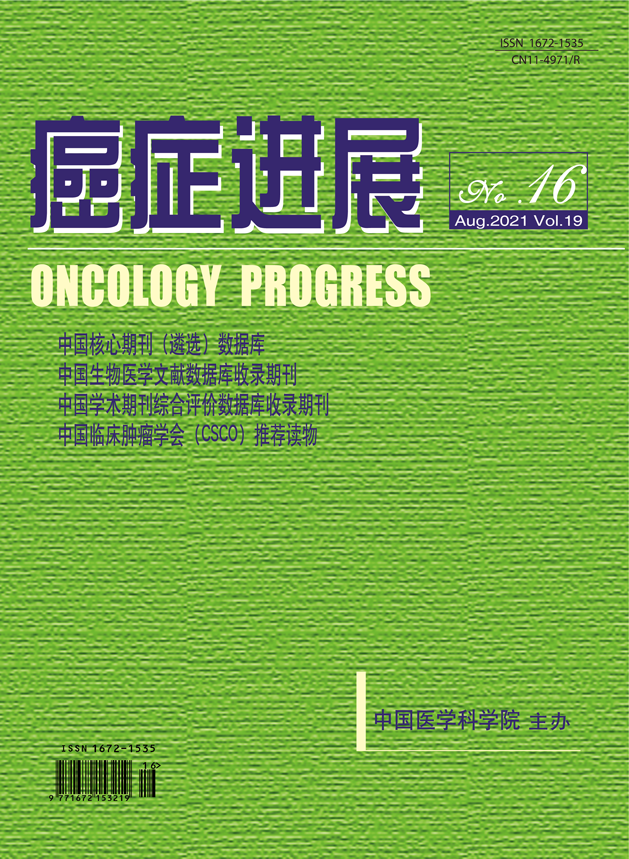杂志信息/Information

- 刊名:癌症进展
- Oncology Progress Journal
- 主管:国家卫生健康委员会
- 主办:中国医学科学院
- 社长:张凌
- 主编:赵平
- 编辑部主任:穆红
- 出版单位:中国协和医科大学出版社有限公司
《癌症进展》编辑部
100730,北京东单三条9号
联系电话:010-57528109
E-mail:azjzzz@163.com
http://www.aizhengjinzhan.com - 印刷:北京联合互通彩色印刷有限公司
- 国内统一连续出版物号:CN 11-4971/R
- 国际标准连续出版物号ISSN 1672-1535
下载专区/Download
订阅电子期刊/Subscribe
提交您的邮箱地址,我们会定期将电子期刊 发送到您的邮箱
期刊检索/Journal Search
扫一扫,关注

2017 年第 1 期 第 15 卷
食管癌术后食管胃吻合口瘘采用瘘腔引流管治疗价值分析
作者:
单位:
- 摘要:
- 【摘要】目的 观察评价胸腔引流管为主的“三管”法和透视引导下经鼻瘘腔负压引流管置入为主的新“三管”法治疗食管癌术后食管胃吻合口瘘的近期治疗效果。方法 90例食管癌术后食管胃吻合口瘘患者随机分为对照组与观察组(各45例)。对照组采用胸腔引流管为主的“三管”法治疗;而观察组采用透视引导下经鼻瘘腔负压引流管置入为主的新“三管”法治疗治疗。比较两组的平均住院时间、疼痛VAS评分、体力恢复状况、镇静评分等指标。结果 观察组患者平均住院时间为(27.41±10.23)天明显低于对照组(53.26±13.27)天(t=9.005, P<0.0001);观察组的疼痛VAS评分、ZPS评分(2.70±1.47、2.11±0.82)均明显低于对照组(6.58±4.32、3.87±1.98)(t=10.003, P<0.0001; t=8.273, P<0.0001);两组镇静Ramsay评分差异比较无统计学意义(t=0.215, P=0.832);观察组病死率(4.44%)明显低于对照组(26.67%),治愈人数(84.44%)明显高于对照组(51.11%),观察组的预后明显优于对照组,差异具有统计学意义(Z=3.498, P=0.000)。结论 临床应用经鼻瘘腔引流管置入为主的新“三管”法治疗食管癌术后食管胃吻合口瘘,其操作较简单,可提高患者治愈率,缩短治愈时间,值得进一步推广。
- Objective To observe and evaluate the "three tube" therapy based Chest tube and the new treatment based on fluoroscopically guided nasal fistula suction drainage tube for postoperative esophageal anastomotic fistula. Methods 90 esophageal anastomotic fistula after esophagus were randomly divided into control group and the observation group (n=45). The control group received chest tube based "three tube" therapy; and the observation group received fluoroscopic guidance nasal cavity suction drainage tube placement based new treatment. The average length of hospital stay, pain VAS scores, physical recovery situation, sedation scores and other indicators were compared. Results The average length of stay of observation group was (27.41 ± 10.23) days, which was significantly lower than the control group (53.26 ± 13.27) days (t = 9.005, P <0.0001); VAS pain scores, ZPS score of the observation group (2.70 ± 1.47,2.11 ± 0.82) were significantly lower than those of the control group (6.58 ± 4.32,3.87 ± 1.98) (t = 10.003, P <0.0001; t = 8.273, P <0.0001); Ramsay sedation scores between the two groups was not statistically significant (t = 0.215, P = 0.832); mortality rate (4.44%) of observation group was significantly lower than that of the control group (26.67%), the number of cured (84.44%) was significantly higher (51.11%), the prognosis observation group than the control group The difference was statistically significant (Z = 3.498, P = 0.000). Conclusions The clinical application of nasal fistula drainage into the main chamber of the new "three tube" Treatment for Postoperative esophageal anastomotic fistula, the operation is relatively simple and can improve patient cure rate and shorten healing time.








